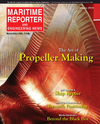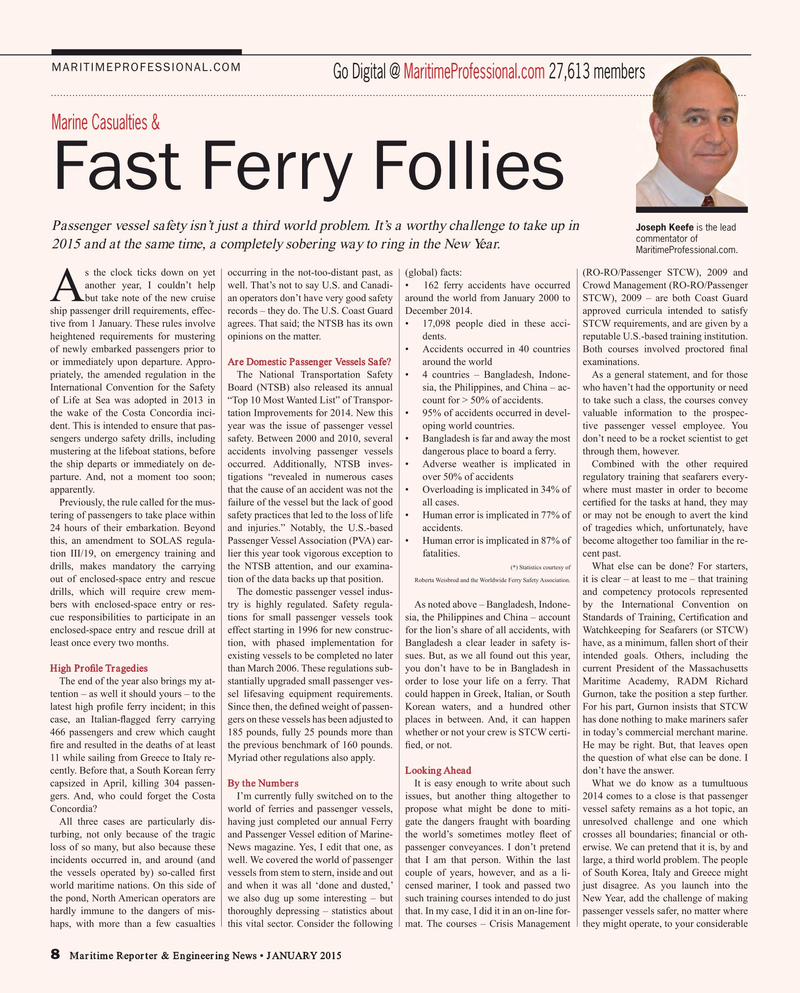
Page 8: of Maritime Reporter Magazine (January 2015)
Ship Repair & Conversion Edition
Read this page in Pdf, Flash or Html5 edition of January 2015 Maritime Reporter Magazine
MARITIMEPROFESSIONAL.COM
Go Digital @ MaritimeProfessional.com 27,613 members rs
Marine Casualties &
Fast Ferry Follies
Passenger vessel safety isn’t just a third world problem. It’s a worthy challenge to take up in
Joseph Keefe is the lead commentator of 2015 and at the same time, a completely sobering way to ring in the New Year.
MaritimeProfessional.com.
s the clock ticks down on yet occurring in the not-too-distant past, as (global) facts: (RO-RO/Passenger STCW), 2009 and another year, I couldn’t help well. That’s not to say U.S. and Canadi- • 162 ferry accidents have occurred Crowd Management (RO-RO/Passenger
Abut take note of the new cruise an operators don’t have very good safety around the world from January 2000 to STCW), 2009 – are both Coast Guard ship passenger drill requirements, effec- records – they do. The U.S. Coast Guard December 2014. approved curricula intended to satisfy tive from 1 January. These rules involve agrees. That said; the NTSB has its own • 17,098 people died in these acci- STCW requirements, and are given by a heightened requirements for mustering opinions on the matter. dents. reputable U.S.-based training institution. of newly embarked passengers prior to • Accidents occurred in 40 countries Both courses involved proctored ? nal or immediately upon departure. Appro- Are Domestic Passenger Vessels Safe? around the world examinations.
priately, the amended regulation in the The National Transportation Safety • 4 countries – Bangladesh, Indone- As a general statement, and for those
International Convention for the Safety Board (NTSB) also released its annual sia, the Philippines, and China – ac- who haven’t had the opportunity or need of Life at Sea was adopted in 2013 in “Top 10 Most Wanted List” of Transpor- count for > 50% of accidents. to take such a class, the courses convey the wake of the Costa Concordia inci- tation Improvements for 2014. New this • 95% of accidents occurred in devel- valuable information to the prospec- dent. This is intended to ensure that pas- year was the issue of passenger vessel oping world countries. tive passenger vessel employee. You sengers undergo safety drills, including safety. Between 2000 and 2010, several • Bangladesh is far and away the most don’t need to be a rocket scientist to get mustering at the lifeboat stations, before accidents involving passenger vessels dangerous place to board a ferry. through them, however. the ship departs or immediately on de- occurred. Additionally, NTSB inves- • Adverse weather is implicated in Combined with the other required parture. And, not a moment too soon; tigations “revealed in numerous cases over 50% of accidents regulatory training that seafarers every- apparently. that the cause of an accident was not the • Overloading is implicated in 34% of where must master in order to become
Previously, the rule called for the mus- failure of the vessel but the lack of good all cases. certi? ed for the tasks at hand, they may tering of passengers to take place within safety practices that led to the loss of life • Human error is implicated in 77% of or may not be enough to avert the kind 24 hours of their embarkation. Beyond and injuries.” Notably, the U.S.-based accidents. of tragedies which, unfortunately, have this, an amendment to SOLAS regula- Passenger Vessel Association (PVA) ear- • Human error is implicated in 87% of become altogether too familiar in the re- tion III/19, on emergency training and lier this year took vigorous exception to fatalities. cent past.
drills, makes mandatory the carrying the NTSB attention, and our examina- What else can be done? For starters, (*) Statistics courtesy of
Roberta Weisbrod and the Worldwide Ferry Safety Association.
out of enclosed-space entry and rescue tion of the data backs up that position. it is clear – at least to me – that training drills, which will require crew mem- The domestic passenger vessel indus- and competency protocols represented bers with enclosed-space entry or res- try is highly regulated. Safety regula- As noted above – Bangladesh, Indone- by the International Convention on cue responsibilities to participate in an tions for small passenger vessels took sia, the Philippines and China – account Standards of Training, Certi? cation and enclosed-space entry and rescue drill at effect starting in 1996 for new construc- for the lion’s share of all accidents, with Watchkeeping for Seafarers (or STCW) least once every two months. tion, with phased implementation for Bangladesh a clear leader in safety is- have, as a minimum, fallen short of their existing vessels to be completed no later sues. But, as we all found out this year, intended goals. Others, including the
High Pro? le Tragedies than March 2006. These regulations sub- you don’t have to be in Bangladesh in current President of the Massachusetts
The end of the year also brings my at- stantially upgraded small passenger ves- order to lose your life on a ferry. That Maritime Academy, RADM Richard tention – as well it should yours – to the sel lifesaving equipment requirements. could happen in Greek, Italian, or South Gurnon, take the position a step further. latest high pro? le ferry incident; in this Since then, the de? ned weight of passen- Korean waters, and a hundred other For his part, Gurnon insists that STCW case, an Italian-? agged ferry carrying gers on these vessels has been adjusted to places in between. And, it can happen has done nothing to make mariners safer 466 passengers and crew which caught 185 pounds, fully 25 pounds more than whether or not your crew is STCW certi- in today’s commercial merchant marine. ? re and resulted in the deaths of at least the previous benchmark of 160 pounds. ? ed, or not. He may be right. But, that leaves open 11 while sailing from Greece to Italy re- Myriad other regulations also apply. the question of what else can be done. I cently. Before that, a South Korean ferry Looking Ahead don’t have the answer.
capsized in April, killing 304 passen- By the Numbers It is easy enough to write about such What we do know as a tumultuous gers. And, who could forget the Costa I’m currently fully switched on to the issues, but another thing altogether to 2014 comes to a close is that passenger
Concordia? world of ferries and passenger vessels, propose what might be done to miti- vessel safety remains as a hot topic, an
All three cases are particularly dis- having just completed our annual Ferry gate the dangers fraught with boarding unresolved challenge and one which turbing, not only because of the tragic and Passenger Vessel edition of Marine- the world’s sometimes motley ? eet of crosses all boundaries; ? nancial or oth- loss of so many, but also because these News magazine. Yes, I edit that one, as passenger conveyances. I don’t pretend erwise. We can pretend that it is, by and incidents occurred in, and around (and well. We covered the world of passenger that I am that person. Within the last large, a third world problem. The people the vessels operated by) so-called ? rst vessels from stem to stern, inside and out couple of years, however, and as a li- of South Korea, Italy and Greece might world maritime nations. On this side of and when it was all ‘done and dusted,’ censed mariner, I took and passed two just disagree. As you launch into the the pond, North American operators are we also dug up some interesting – but such training courses intended to do just New Year, add the challenge of making hardly immune to the dangers of mis- thoroughly depressing – statistics about that. In my case, I did it in an on-line for- passenger vessels safer, no matter where haps, with more than a few casualties this vital sector. Consider the following mat. The courses – Crisis Management they might operate, to your considerable 8 Maritime Reporter & Engineering News • JANUARY 2015
MR #1 (1-9).indd 8 MR #1 (1-9).indd 8 1/9/2015 9:11:50 AM1/9/2015 9:11:50 AM

 7
7

 9
9
